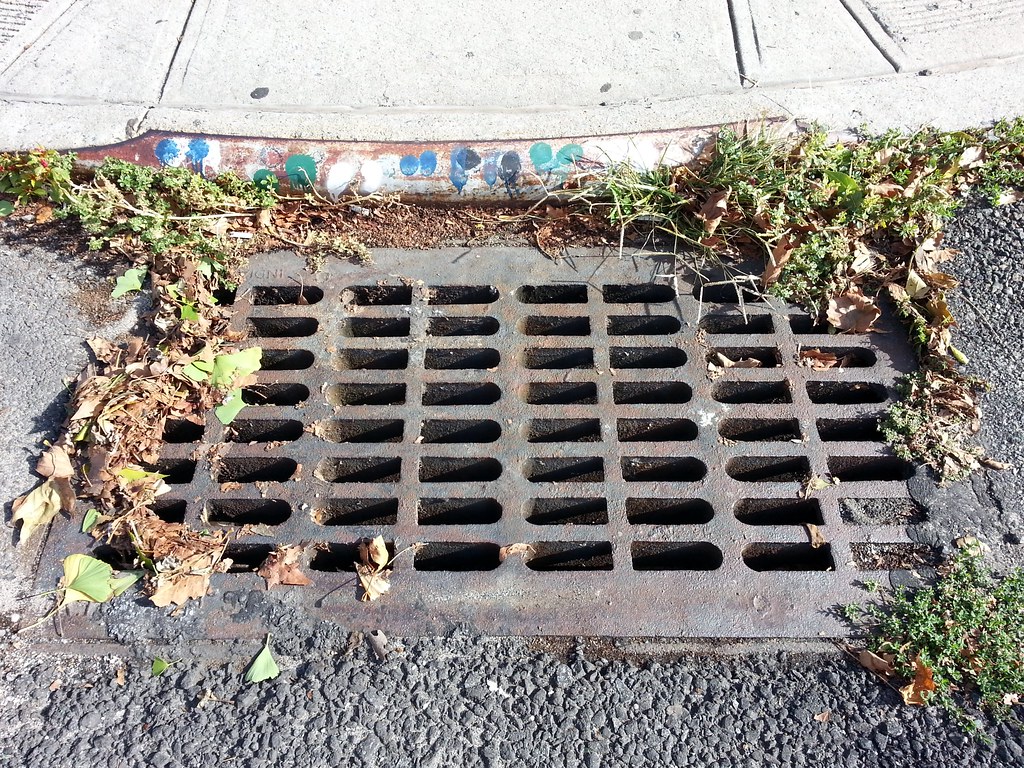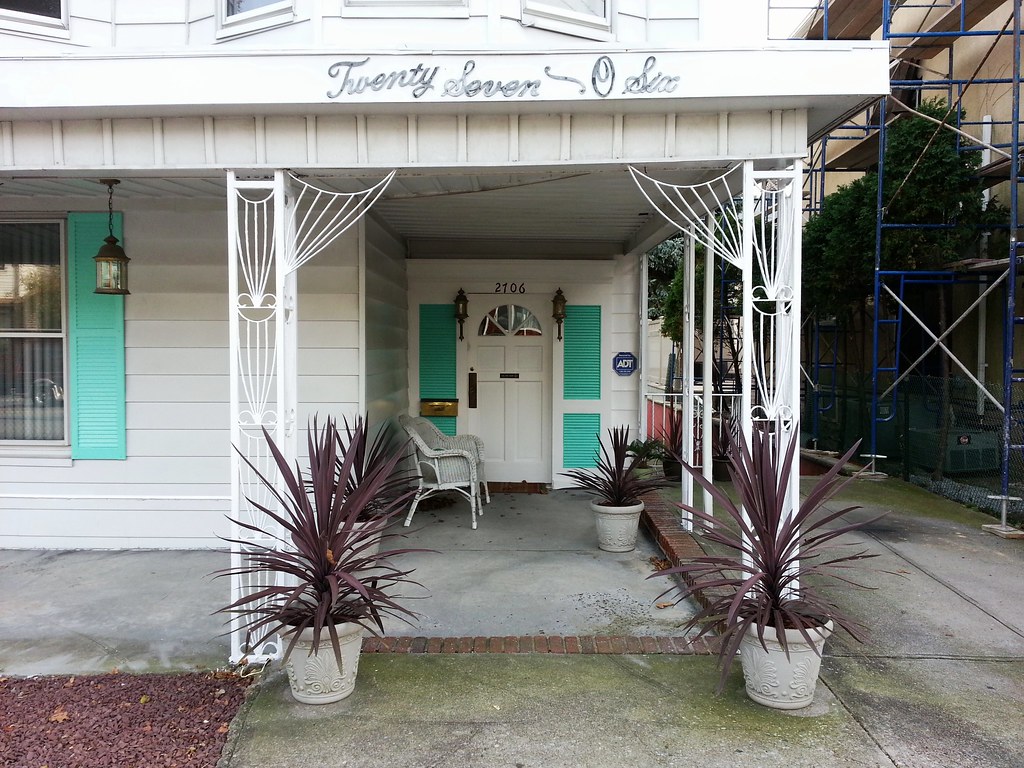
This two-story brick shell and its neighbor appear to serve as something of a portico to the taller building rising behind them.

This Italianate mansion actually predates Prospect Park, in which it is now contained. It currently serves as the Parks Department's Brooklyn headquarters.

This is the outdoor seating area — complete with the phony facade of a charming wooden house — of a new Turkish cafe built where an old warehouse once stood.

The private company that has long operated this public bus line (which provides service between the heavily Hasidic Brooklyn neighborhoods of Borough Park and Williamsburg) found itself briefly in hot water a couple of years ago over the segregation of men and women on its buses. Ultra-Orthodox Judaism requires such separation of the sexes, but even non-Jewish women were reportedly being told that they had to sit in the back of the bus. After receiving a warning letter from the city DOT, however, the company said it would take steps to end the practice.

In 1975, in anticipation of eventually turning the area into a waterfront park, the city condemned the property on which this concrete plant stands, turning Mr. Ferrera from a landowner into a tenant; he's been renting his land back from the city ever since. There was talk of finally evicting the plant a few years ago and replacing it with a residential development and some parkland, but that plan appears to have gone nowhere.

Asbestos killed the company, but the sign's still hanging in there.

Time-lapse plant photography on a raft in the Gowanus Canal

The building in the center, currently the home of Noble Dental Care, was once a branch of the South Brooklyn Savings and Loan Association.

Built in 1856-57; formerly the headquarters of the Higgins Ink Company

This graffitied-over Revolutionary War mural painted on the side of an American Legion post in Gowanus, Brooklyn overlooks the vacant lot where some local historians believe as many as 256 members of the Maryland 400, the gravely outnumbered soldiers whose self-sacrificial counterattacks against the British during the Battle of Brooklyn "saved the American army", lie buried in a mass grave.

I'm taking this photo from a strange little public waterfront area at the edge of a Lowe's parking lot. Up on the Culver Viaduct, you can see a southbound G train about to enter the Smith–Ninth Streets station, which stands 87.5 feet above street level, making it the highest subway station in the world, according to the MTA.

Once you start noticing these colored dots of spray paint on the curb above storm drains, you see them everywhere. I believe each pair of dots indicates that the grate was cleaned during a certain year the catch basin beneath the grate was treated with larvicide during a certain period of time in an effort to kill the mosquitoes that transmit West Nile virus.

Takes me back to the days of Tony Q-69.
(Last name and home address redacted.)

If you glance at a map of Sheepshead Bay, Brooklyn, you'll notice that Jerome Avenue appears to exist only between Sheepshead Bay Road on the west and East 23rd Street on the east. So why is there a Jerome Avenue address here on East 28th Street?
It's because Jerome Avenue existed long before the current street grid, and it once extended farther east than it does today. This is clearly apparent when you look at an aerial image: following the road's trajectory east from East 23rd Street, you'll notice a string of mid-block diagonal walls and fence lines that trace its former right-of-way. But when this eastern section of Jerome Avenue was wiped out some years ago, a tiny piece of it was preserved as a driveway east of East 28th Street because there's a single house here that once fronted on Jerome Avenue and is not accessible from any of the other surrounding streets. It would be stranded in the middle of the block if it weren't for this little surviving stretch of Jerome Avenue connecting it to East 28th Street. And so the house has managed to maintain its now-mysterious-seeming address of yore on an unsigned, gated-off remnant of the bygone thoroughfare that once flowed past its walls.

According to Kevin Walsh (scroll down a bit), this is one of only two surviving 19th-century gas street-lamp posts in the city. (The other one, which we've already visited, is on Patchin Place in Greenwich Village.)

The skinny brown thing embedded in the wall is an old milestone, probably dating from 1813. It once stood a couple of blocks away on the Kingsbridge Road (today's Broadway), just south of what is now 204th Street, where it informed travelers that they were "12 Miles from N. York", that distance having been measured from City Hall. When the Kingsbridge Road was widened sometime in the latter half of the 1800s, the road workers tossed out the old milestone. It was rescued by William B. Isham, who had it built into the retaining wall beside the entrance to what was then his estate and is now Isham Park.
You can see some cool old photos of the stone and the wall here. (The linked page claims that the stone was originally an 18th-century Post Road mile marker, but that seems quite unlikely. Richard J. Koke, who authored an extensive study of the city's milestones in 1950, had concluded by 1964 that the stone was not that old.)

From The Metropolitan Museum of Art's website:
The Cloisters museum and gardens, which opened to the public in 1938, is the branch of The Metropolitan Museum of Art devoted to the art and architecture of medieval Europe. Located in Fort Tryon Park in northern Manhattan, on a spectacular four-acre lot overlooking the Hudson River, the modern museum building is not a copy of any specific medieval structure but is rather an ensemble informed by a selection of historical precedents, with a deliberate combination of ecclesiastical and secular spaces arranged in chronological order. Elements from medieval cloisters—Saint-Michel-de-Cuxa, Saint-Guilhem-le-Désert, Trie-sur-Baïse, Froville, and elements once thought to have come from Bonnefont-en-Comminges—and from other sites in Europe have been incorporated into the fabric of the building.
Three of the reconstructed cloisters feature gardens planted according to horticultural information found in medieval treatises and poetry, garden documents and herbals, and medieval works of art such as tapestries, stained-glass windows, and column capitals. Approximately two thousand works of art from medieval Europe, largely dating from the twelfth through the fifteenth century and including exquisite illuminated manuscripts, stained glass, metalwork, enamels, ivories, and tapestries, are exhibited in this unique context.

In 1909, C.K.G. Billings (he of the horse-mounted dinner party) funded the erection of this massive plaque on his property, on the former site of Fort Tryon in what is now Fort Tryon Park, to commemorate the Revolutionary Battle of Fort Washington and specifically the efforts and sacrifice of Margaret Corbin, who, according to the plaque, was "the first American woman to take a soldier's part in the War for Liberty". As you may recall, Corbin Place in Sheepshead Bay was officially redesignated in Mrs. Corbin's honor a few years ago after the brouhaha over the involvement of Austin Corbin (the street's original eponym) in the fictional-but-widely-believed-to-be-real American Society for the Suppression of the Jews.

This neoclassical roadside shelter at Inspiration Point on the Hudson River was "built in 1925 as a destination point for promenaders and pleasure drivers." Here's a photo from its early days, when it had a lower level with restrooms open to the public.
Not surprisingly, this scenic area was apparently once a popular lovers' lane: a 1920 NY Times article described Inspiration Point as "a mecca for automobile 'spooners' " and reported on one magistrate's attempt to crack down on the practice by instituting ten-day jail sentences for those caught in the act.
The roadside shelter is no longer accessible from the road; it can only be reached from the recreational path running beside the Henry Hudson Parkway. It's also not much of a shelter anymore, as its roof was replaced with an open, arbor-like structure during a much-needed restoration in the 1990s.
































